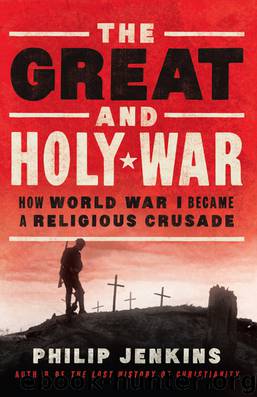The Great and Holy War by Philip Jenkins

Author:Philip Jenkins
Language: eng
Format: epub
Publisher: HarperCollins
Published: 2016-01-04T16:00:00+00:00
The “Hate Song” remained popular throughout both world wars. Yet despite receiving high praise from the court and the army, the song’s fanatical sentiments made it controversial among the Far Right, and anti-Semites rejected it as un-German. Surely, they protested, Lissauer’s monomaniacal attack on an enemy nation must have stemmed from his warped grounding in the Hebrew tradition. Real Germans knew nothing of such implacable hatred against any nation or race.
The Russian Ogre
FOR JEWISH COMMENTATORS on the war, Germany had one supreme advantage, namely that it was not Russia. However much anti-Semitism might surface in Germany, German Jews were in a superbly better position than their counterparts in the Russian realms, where anti-Semitism was codified in law, and where anti-Jewish hatred might at any moment erupt into a riot or show trial. The very word “pogrom” was a pernicious Russian contribution to human culture, which gained currency in English in the 1880s. Despite the efforts of individual prelates, anti-Semitism was deeply ingrained in the Orthodox Church, which exercised such influence at court. Some clergy supported the Black Hundreds, the anti-Semitic gangs that were the ancestor of all Europe’s twentieth-century Fascist paramilitary groups.11
Anti-Semitic ideologies were also growing apace within Russia. Growing political tensions in the late nineteenth century drove reactionaries to blame Jews for the unrest, commonly with the assumption that subversives were motivated by a diabolical hostility toward Holy Orthodox Russia. While many Jews were gaining emancipation across Europe in these years and seeking full political rights, anti-Jewish campaigns were reviving some of the grimmest atrocity stories of the Middle Ages, including the blood libel—the legend that Jews sacrificed Christian children as a required part of their faith. However archaic in form, the story resonated wonderfully with blood-centered themes of the age, including the popular cult of blood sacrifice for the good of the nation, and racial purity. Blood-libel stories surfaced in the Ottoman Empire in the mid-nineteenth century and somewhat later in Austria-Hungary, but it was especially on Russian soil that these tales found their most hospitable setting. In 1903, a deadly pogrom in Kishinev (in present-day Moldova) was fueled by charges that Jews had killed a Christian boy to use his blood for Passover matzo. Similar accusations led to the sensational 1913 trial of Menachem Mendel Beilis in Kiev, which gave European liberals still further proof of the repressive and superstitious nature of the tsarist regime. It also convinced many thousands of Russian Jews of the urgent need to emigrate.12
The situation in Russia was by no means wholly bleak, and many Jews had established solid positions for themselves in a large and complex empire with many local variations and distinctions. But future prospects did not look promising. Russia’s reputation for intolerance was actually growing in the years before the war, as the regime offered frightening plans to return to the Pale of Settlement those Jews who had migrated to other regions—in effect a far-reaching ethnic cleansing of Jewish professionals and intellectuals.13 In contrast to these horrors, Germany represented modernity, emancipation, and civilization.
Download
This site does not store any files on its server. We only index and link to content provided by other sites. Please contact the content providers to delete copyright contents if any and email us, we'll remove relevant links or contents immediately.
| Buddhism | Christianity |
| Ethnic & Tribal | General |
| Hinduism | Islam |
| Judaism | New Age, Mythology & Occult |
| Religion, Politics & State |
Cecilia; Or, Memoirs of an Heiress — Volume 1 by Fanny Burney(31349)
Cecilia; Or, Memoirs of an Heiress — Volume 3 by Fanny Burney(30947)
Cecilia; Or, Memoirs of an Heiress — Volume 2 by Fanny Burney(30907)
The Secret History by Donna Tartt(16656)
Sapiens: A Brief History of Humankind by Yuval Noah Harari(13073)
Leonardo da Vinci by Walter Isaacson(11916)
The Radium Girls by Kate Moore(10915)
Sapiens by Yuval Noah Harari(4551)
The Wind in My Hair by Masih Alinejad(4427)
How Democracies Die by Steven Levitsky & Daniel Ziblatt(4412)
Homo Deus: A Brief History of Tomorrow by Yuval Noah Harari(4289)
Endurance: Shackleton's Incredible Voyage by Alfred Lansing(3854)
The Silk Roads by Peter Frankopan(3779)
Man's Search for Meaning by Viktor Frankl(3647)
Millionaire: The Philanderer, Gambler, and Duelist Who Invented Modern Finance by Janet Gleeson(3575)
The Rape of Nanking by Iris Chang(3526)
Hitler in Los Angeles by Steven J. Ross(3446)
The Motorcycle Diaries by Ernesto Che Guevara(3344)
Joan of Arc by Mary Gordon(3269)
